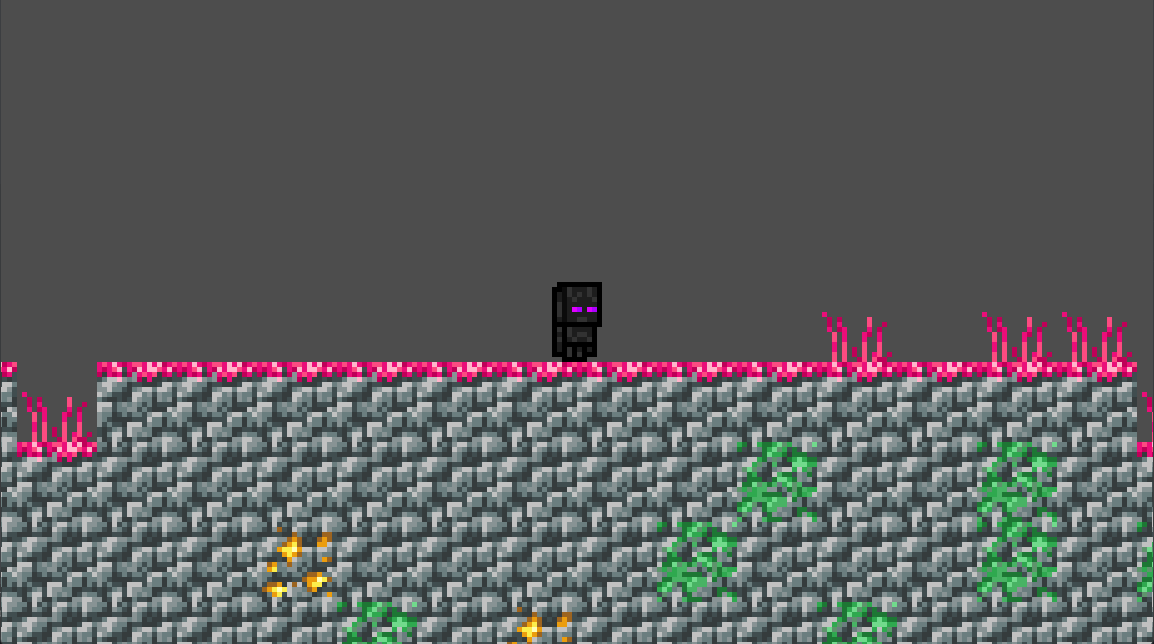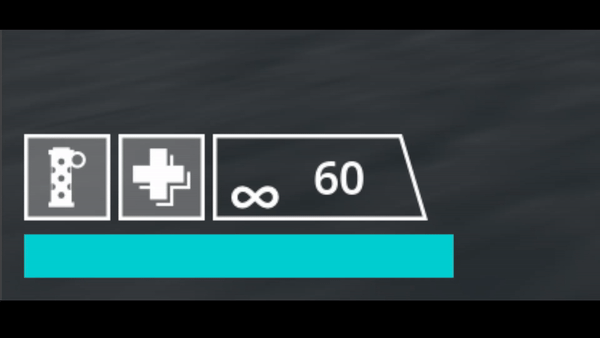Just some useful Godot snippets for things.
Contents:
- Procedural Terrain
- Health and Shield Gating
- Titanfall's Ability Recharge
- Context Abilities
- Random Generators
Procedural Generation is all over the place. It mostly plays a role in creating level content in rogue-like and survival games. A simple Terraria-style 2D level generator can be done as follows: Create a Node2D scene to act as our chunk generator. For every tile add a StaticBody2D with a CollisionShape and Sprite2D as it's children, with each texture being assigned to the sprite. Add additional Sprite only textures for decorations, like grass and flowers. Then add a script to the scene:
extends Node2D
#Called when the node enters the scene tree for the first time.
func _ready():
generate()
func generate(): #Generates the terrain
var textures = [$ore, $moss]
var plants = [$plant, $tulip, $flower]
var noise = FastNoiseLite.new()
noise.seed = randf_range(-1000, 1000)*randf()
for x in range(0, get_window().size.x+16, 16): #This code gnerates a noisey line of grass blocks at a determined hight.
var k = round(noise.get_noise_1d(x)*3)*16 + 1080/1.5
var grass_block = $grass.duplicate()
grass_block.global_position = Vector2(x,k)
add_child(grass_block)
var spawn = randf() #This is used to roll a random number.
if spawn < 0.15: #Decorations are also spawned in at random in this pass.
var plant = plants.pick_random().duplicate()
plant.global_position = Vector2(x,k-16)
add_child(plant)
elif spawn > 0.75:
var plant = $plant.duplicate()
plant.global_position = Vector2(x,k-16)
add_child(plant)
for y in range(k+16, 1080, 16): #Then every space below the grass is filled in with stone.
var i = randf() #this is used to roll a random number.
if i > 0.25:
var block = $stone.duplicate()
block.global_position = Vector2(x,y)
add_child(block)
else:
var block = textures.pick_random().duplicate()
block.global_position = Vector2(x,y)
add_child(block)I use FastNoiseLite to generate one-dimensional noise with a randomly picked seed value. The code is set up to snap the placed blocks to a 16px grid. In my code, I use arrays to randomly select decorations and special blocks. The end results looks like this:
In the above code I assigned variables random floats whenever I needed to roll a dice. But a much cleaner and more versitile solution would be to create a function that assignes a global variable:
var coin = 0 #Place at top of code.
func coinFlip():
coin = randf() #randf() will generate a float value between 0 and 1.
coinFlip() #Called wherever needed.The main disadvantage to this, is that it can sometimes break things when multiple functions are using it. But for our terrain generator that only needs to run once, it works just fine.
Health Gating is a QoL feature in some games that prevents a player from being killed too quickly. It might not be an option for every games, especially in multiplayer shooters where Snipers and Shotguns are in play. But it can be a good accessability in other genres. Implementing such a system is as simple as containing our damage function in an if-statement that checks if the health is above our threshold, and if so, capping the damage to a set value.
var Health = 100 #Global variable
func health(damage: float):
if damage >= Health and Health == 100:
Health = 20
else:
Health -= damageIn this scenario, the function checks if the incoming damage is going to be more than the player's available health. If the player's health is full, the damage is capped to only being able to deal 80 damage.
In some games, such as Warframe, you may have both a health and shield bar. This can be gated to prevent the player from taking damage while they still have shield.
var Health = 100 #Global variables
var Shield = 100
func health(damage: float):
if damage >= Shield and Shield > 0:
Shield = 0
elif damage <= Shield:
Shield -= damage
else:
Health -= damageThis is my implementation of the UI for recharging abilities, as seen in Titanfall 2. To set this up, I set up our ui element for the ability icon and placed a translucent ProgressBar sized and aligned behind it. The functions below are set up to allow a grenade to be thrown twice, and are placed in our setup code and called in the physics_process. The first function simply decreases the progress bar by 50% if the ability action is pressed, while the second function constinuously refills it when it is below 100%.
func grenade():
if Input.is_action_just_pressed("grenade_throw"):
if grenade_recharge.value >= 50:
grenade_recharge.value -= 50
# additional code for grenade or other ability
func recharge():
if grenade_recharge.value < 100:
grenade_recharge.value += 0.2 #controls the recharge speedBe sure to set the progress bar's Fill Mode to "Bottom to Top". The resulting effect is this:
Our player also has an ability that fully restores their health. Combine this with it's longer cooldown, and it proves a vital tool for survival in a firefight. Becasue of this, we want to make sure the player can't waste the ability or accidentlly trigger it. We can modify the code we used for health gating to accomplish this.
func heal():
if Input.is_action_just_pressed("res"):
if Health <= 50:
Health = 100
else:
passHere, we prevent the player from activating the ability if their health is above 50%, but this can be set to any ammount, depending on the pacing of your gameplay.
If your game requires a more predictable way of generation, maybe you're making a game like Minecraft, where players can share level seeds, you may want to roll your own number generator instead of relying on built in functions. In this section, I'll cover how generators work, with examples of some famous random number generators.
Linear-Feedback Shift Register
Also just called an LFSR, this was the standard for RNG in retro video games. Everything from Pac-Man to Pokemon used it in some form. It works by taking a binary input and shifting the bits around to output a single binary value. This process would be repeated a number of times or continuously and then a sample of the whole string of outputs would be converted into an integer, and processed further whenever needed.
#Tetris's LFSR
var seed = 35208 #01000100110001000
var bit = 1
function lfsr(seed):
bit = seed & 1
seed = ((((seed >> 9) & 1) ^ ((seed >> 1) & 1)) << 15) | (seed >> 1)
lfsr(seed) #place in physics_process()A downside to LFSRs is that, because we are working with binary, there is a limit to how many it can generate before repeating. This limit depends on how you implement it. Tetris's LFSR works by taking the starting binary value and comparing the 1st and 9th bits in an xor operation. An Exlusive OR switch compares two boolean or binary states and only returns 1 if they are different. Otherwise it returns 0.
Linear Congruential Generator
This algorithm is the star of Minecraft's world generation. It involves taking in the seed, multplying it by a random number, incrementing the result and taking the modulo with some number.
#Minecraft's World Generator
var seed = 8276324
seed = ((25214903917 * seed) + 11) % pow(2,48) #result equals 113756703365023
